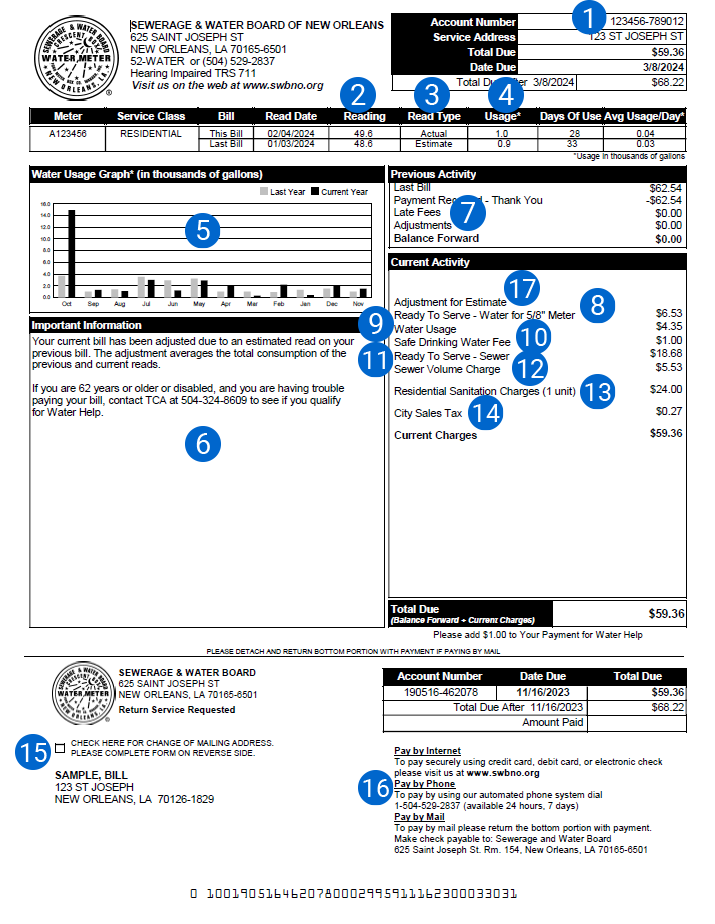Understanding Your Bill
This interactive image will help you to understand many parts of your bill. Simply hover over the parts of your bill that you wish to learn more about and information will be displayed near your cursor. You may download or print this sample bill here .

| 1 | The first six digits of the Account Number is the location number that is unique to that service address. The second six digits is the customer number which should be the same across all accounts owned by the same customer. |
| 2 | Reading is the numbers read off the dial of your water meter. To determine how many gallons of water has passed through your meter since it was installed, multiply the difference between your previous reading and your current reading by 1,000. |
| 3 | Read Type indicates if your meter reading was an Actual reading of your meter's dials, or if it was an Estimate of your water usage since your last bill, because we were not able to read your meter this month. |
| 4 | Usage is your water usage for this billing period. To determine how many gallons of water has passed through your meter since the last reading, multiply your current month's usage by 1,000. |
| 5 | Use this graph to monitor your water usage from month to month. The current month is on the far left. |
| 6 | Look here for important messages specific to your account, your street, or your community. |
| 7 | The Sewerage and Water Board charges a 10% Late Fee for the unpaid water and sewer balance remaining after the bill due date, and 15% of the unpaid sanitation charges remaining after the bill due date. |
| 8 | Ready to Serve - Water is the Monthly Water Service Charge that covers the fixed costs of maintaining the treatment plants, pumping stations, and underground pipes. These charges are billed even if no water is used. To learn more, see our Rates, Fees & Charges. |
| 9 | Water Usage is the Water Quantity Charge calculated as the difference between the previous meter reading and the most recent meter reading. To learn more, see our Rates, Fees & Charges. |
| 10 | A $1.00 per month Safe Drinking Water Fee is assessed for every meter servicing drinking water in the State of Louisiana. The Louisiana Legislature on April 19, 2000 authorized the Safe Drinking Water Fee for the benefit of the Department of Health (DHH) to perform all inspections, tests or procedures of public water supplies to comply with the federal Safe Drinking Water Act. |
| 11 | Ready to Serve - Sewer is the Monthly Sewer Service Charge that covers the fixed costs of maintaining the treatment plants, pumping stations, and underground pipes. These charges are billed even if no water is used. To learn more, see our Rates, Fees & Charges. |
| 12 | Sewer Volume Charge Charge is based on the Water Quantity Charge for the same billing period. All Residential and Public Housing Class quantity charges are applied to 85 percent of the metered water consumption, allowing 15 percent of water use for lawn watering and other uses that contribute no flow to the sanitary sewer. Quantity charges for Commercial and Industrial Classes of customers are based on 100% of metered water consumption. To learn more, see our Rates, Fees & Charges. |
| 13 | Sanitation Charges are collected on behalf of the City of New Orleans for garbage and recycling pickup. The sanitation rate is multiplied times the number of living units served by each water meter. To learn more, see Sanitation Services. |
| 14 | City Sales Tax is 2 1/2% of water charges. |
| 15 | To change your mailing address or contact information, check here and fill out the Change of Mailing Address Form on the back of your bill. |
| 16 | You may pay your Sewerage and Water Bill using any of these convenient methods, or you may visit one of our customer service centers. |
| 17 | Adjustment for estimate - When a customer receives an actual read bill immediately following an estimated read bill and consumption units fell into different tiers, the actual-read bill will be adjusted for any difference by spreading the consumption units over both bills resulting in a credit or charge that reflects the true usage over the two bills. The first bill is never modified since it was already posted and the adjustment for estimate is credited on the second bill. |
For more information on how you use water, see Water Use Metrics.